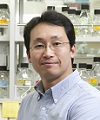 |
Jun-ichi NAKAYAMAProfessor, Ph.D. (Science) | |
|
E-mail: jnakayam TEL: +81-52-872-5866 FAX: +81-52-872-5866 Research Course: Biological Science |
||
| URL http://www.nsc.nagoya-cu.ac.jp/~jnakayam/ | ||
| Specialties | Molecular Biology, Chromatin Dynamics, Epigenetics | |
| Keywords | ||
| Current Research |
Multicellular organisms are made up of diverse populations of many different types of cells, each of which contains an identical set of genetic information coded in its DNA. Cell differentiation and the process of development itself depend on the ability of individual cells to maintain the expression of different genes. In recent years, we have begun to understand that the maintenance of specific patterns of gene expression does not rely on direct modifications to the DNA sequence encoding the organism's genome, but rather takes place in a heritable, "epigenetic" manner. Our laboratory investigates how modifications to the structure and configuration of chromatin (complexes of nuclear DNA and proteins that provide the structural basis of chromosomes) contribute to epigenetic gene regulation and how such modifications are transmitted over generations of cellular division by studying events at the molecular scale in the model organism, fission yeast (Schizosaccharomyces pombe), and in cultured mammalian cells. Research Topics: (1) Revealing the mechanisms underlying the establishment and maintenance of higher-order chromatin structure (2) Characterizing the factors involved in epigenetic gene silencing (3) Characterizing mammalian chromodomain proteins in transcriptional regulation and higher-order chromatin structure |
|
| Selected Papers |
N-terminal phosphorylation of HP1α increases its nucleosome-binding specificity. Nucleic Acids Res. 42: 12498-511 (2014).
Physical and functional interactions between the histone H3K4 demethylase KDM5A and the nucleosome remodeling and deacetylase (NuRD) complex. J Biol Chem. 289: 28956-70 (2014). Intrinsic nucleic acid-binding activity of Chp1 chromodomain is required for heterochromatic gene silencing. Mol Cell 47: 228-41 (2012). Heterochromatin protein 1 homologue Swi6 acts in concert with Ers1 to regulate RNAi-directed heterochromatin assembly. Proc Natl Acad Sci USA. 109: 6159-64 (2012). N-terminal phosphorylation of HP1α promotes its chromatin binding. Mol Cell Biol. 31: 1186-200 (2011). Balance between distinct HP1 family proteins controls heterochromatin assembly in fission yeast. Mol Cell Biol. 28: 6973-88 (2008). siRNA-mediated heterochromatin establishment requires HP1 and is associated with antisense transcription. Mol Cell 31: 178-189 (2008). Two different Argonaute complexes are required for siRNA generation and heterochromatin assembly in fission yeast. Nat Struct Mol Biol. 14: 200-207 (2007). |
|

![[Back]](../images/backE.gif)